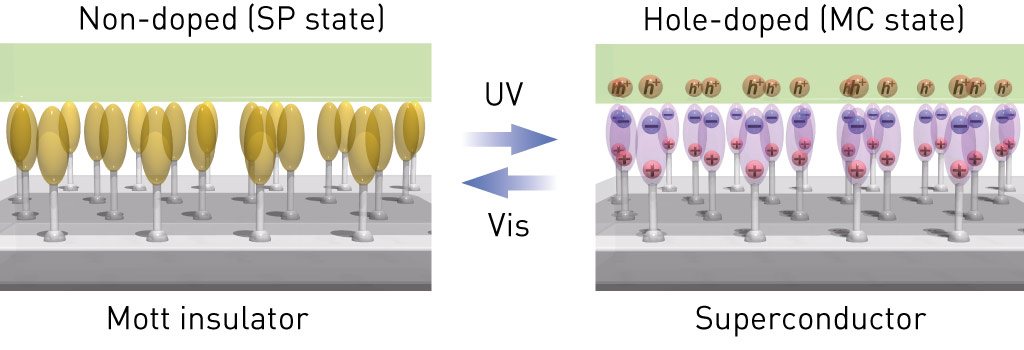A light switch for superconductivity

Figure 1: Irradiating a thin crystal of κ-Br on a monolayer of spiropyran molecules with visible (left) and ultraviolet (right) light switches the κ-Br material between insulating and superconducting states due to the formation of an electric double layer.
Reproduced, with permission, from Ref. 1 (c) 2015 M. Suda et al.
A device that can be switched between insulating and superconducting states by irradiation with light has been developed by researchers from RIKEN and the Institute for Molecular Science (IMS)1. The development could ultimately lead to more efficient superconducting microelectronics.
The properties of solid materials can be dramatically altered by applying an electric field. In a common electronic component called a field-effect transistor, the flow of electrons through a semiconducting channel is controlled according to the strength of an internal electric field, which is created by applying a voltage to an insulating material—a dielectric. Higher field strengths provide more efficient conduction, but at very high fields the dielectric material begins to break down and conduct itself.
To overcome this limitation, scientists have turned to the use of ionic liquids. When a voltage is applied to an ionic liquid, the charged particles in the liquid move to the surface of the channel material, creating an ‘electric double layer’ (EDL) that is not susceptible to dielectric breakdown.
The high electric fields enabled by this technique have previously allowed researchers to convert the channel material from an insulator into a superconductor. So far, switching of the electric field has only been possible at relatively high temperatures because the ionic motion freezes at approximately 200 kelvin. Masayuki Suda and Hiroshi Yamamoto from the IMS and RIKEN, in collaboration with RIKEN’s Reizo Kato, have now shown that a light-sensitive molecule can be used to switch on a superconducting state at temperatures as low as 5 kelvin.
The team replaced the ionic liquid with a single layer of spiropyran molecules, which are ionic under ultraviolet light and non-ionic under visible light. To test this strategy, they placed an organic crystal called κ-Br, which is known to have a superconducting state, on a single layer of self-assembled spiropyran molecules mounted on a thin oxide film. They confirmed that the resistance of the κ-Br switched from a high-resistance state under visible light to a low-resistance state when illuminated with ultraviolet light, due to the formation of an EDL (Fig. 1).
“Even at low temperatures, ultraviolet light induces a zwitterionic structure in spiropyran molecules and a situation very similar to an EDL without an applied voltage, leading to superconductivity,” says Suda.
“In this system, light induces the superconducting state by photoisomerization of the spiropyran molecules,” says Suda. “If we could get light to generate the superconducting carriers directly, other types of light-driven devices could also be possible.”
References
Suda, M., Kato, R. & Yamamoto, H. M. Light-induced superconductivity using a photoactive electric double layer. Science 347, 743–746 (2015). doi: 10.1126/science.1256783 (Link)
